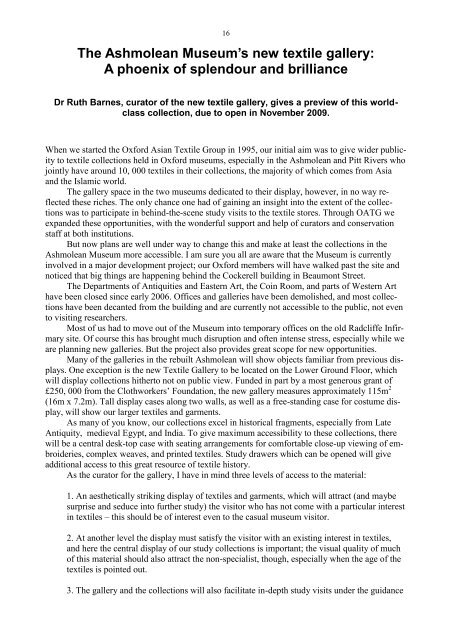Download - OATG. Oxford Asian Textile Group
Download - OATG. Oxford Asian Textile Group
Download - OATG. Oxford Asian Textile Group
Create successful ePaper yourself
Turn your PDF publications into a flip-book with our unique Google optimized e-Paper software.
16<br />
The Ashmolean Museum’s new textile gallery:<br />
A phoenix of splendour and brilliance<br />
Dr Ruth Barnes, curator of the new textile gallery, gives a preview of this worldclass<br />
collection, due to open in November 2009.<br />
When we started the <strong>Oxford</strong> <strong>Asian</strong> <strong>Textile</strong> <strong>Group</strong> in 1995, our initial aim was to give wider publicity<br />
to textile collections held in <strong>Oxford</strong> museums, especially in the Ashmolean and Pitt Rivers who<br />
jointly have around 10, 000 textiles in their collections, the majority of which comes from Asia<br />
and the Islamic world.<br />
The gallery space in the two museums dedicated to their display, however, in no way reflected<br />
these riches. The only chance one had of gaining an insight into the extent of the collections<br />
was to participate in behind-the-scene study visits to the textile stores. Through <strong>OATG</strong> we<br />
expanded these opportunities, with the wonderful support and help of curators and conservation<br />
staff at both institutions.<br />
But now plans are well under way to change this and make at least the collections in the<br />
Ashmolean Museum more accessible. I am sure you all are aware that the Museum is currently<br />
involved in a major development project; our <strong>Oxford</strong> members will have walked past the site and<br />
noticed that big things are happening behind the Cockerell building in Beaumont Street.<br />
The Departments of Antiquities and Eastern Art, the Coin Room, and parts of Western Art<br />
have been closed since early 2006. Offices and galleries have been demolished, and most collections<br />
have been decanted from the building and are currently not accessible to the public, not even<br />
to visiting researchers.<br />
Most of us had to move out of the Museum into temporary offices on the old Radcliffe Infirmary<br />
site. Of course this has brought much disruption and often intense stress, especially while we<br />
are planning new galleries. But the project also provides great scope for new opportunities.<br />
Many of the galleries in the rebuilt Ashmolean will show objects familiar from previous displays.<br />
One exception is the new <strong>Textile</strong> Gallery to be located on the Lower Ground Floor, which<br />
will display collections hitherto not on public view. Funded in part by a most generous grant of<br />
£250, 000 from the Clothworkers‘ Foundation, the new gallery measures approximately 115m 2<br />
(16m x 7.2m). Tall display cases along two walls, as well as a free-standing case for costume display,<br />
will show our larger textiles and garments.<br />
As many of you know, our collections excel in historical fragments, especially from Late<br />
Antiquity, medieval Egypt, and India. To give maximum accessibility to these collections, there<br />
will be a central desk-top case with seating arrangements for comfortable close-up viewing of embroideries,<br />
complex weaves, and printed textiles. Study drawers which can be opened will give<br />
additional access to this great resource of textile history.<br />
As the curator for the gallery, I have in mind three levels of access to the material:<br />
1. An aesthetically striking display of textiles and garments, which will attract (and maybe<br />
surprise and seduce into further study) the visitor who has not come with a particular interest<br />
in textiles – this should be of interest even to the casual museum visitor.<br />
2. At another level the display must satisfy the visitor with an existing interest in textiles,<br />
and here the central display of our study collections is important; the visual quality of much<br />
of this material should also attract the non-specialist, though, especially when the age of the<br />
textiles is pointed out.<br />
3. The gallery and the collections will also facilitate in-depth study visits under the guidance

















